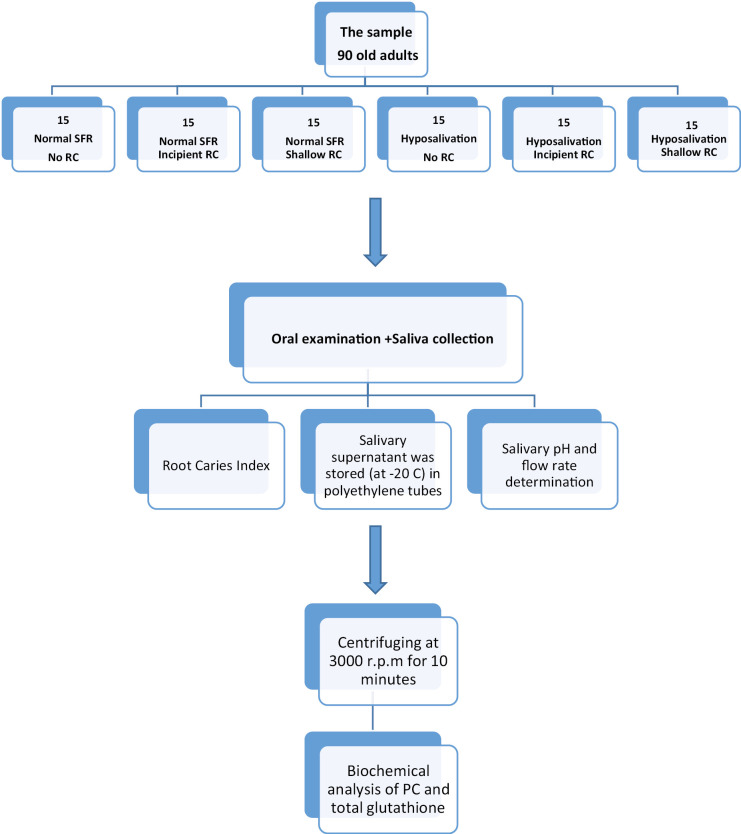唾液蛋白羰基、总谷胱甘肽、pH和流速对根龋严重程度的交互作用:一项病例对照研究
IF 1.4
Q3 DENTISTRY, ORAL SURGERY & MEDICINE
Journal of International Society of Preventive and Community Dentistry
Pub Date : 2023-08-30
eCollection Date: 2023-07-01
DOI:10.4103/jispcd.JISPCD_186_22
引用次数: 0
摘要
目的:唾液中的氧化剂和抗氧化成分在龋齿的发展中起着重要作用。本研究的目的是揭示唾液蛋白羰基(PC)、总谷胱甘肽(GSH)、pH和流速对根龋严重程度的相互作用。材料和方法:对照组和研究组由90名男女老年人组成,分为六组:无根龋正常唾液流量组(对照组)、初根龋正常口腔流量组、浅根龋正常鼻腔流量组、无根龋低唾液流量组、,以及浅根龋引起的牙本质缺失。每组由15名老年人组成。研究参与者是从巴格达大学牙科学院教学医院就诊的符合研究标准的患者中挑选出来的。收集未刺激的唾液。立即测定唾液pH值和流速。之后,对唾液进行生化分析,以比色法测定PC和总GSH水平。根面龋是通过根龋指数进行临床诊断的。使用描述性统计、双向单变量方差分析、双向多变量方差分析和Pearson相关系数(α=5%)对数据进行统计分析。结果:唾液总谷胱甘肽与唾液流量和根腐程度有显著的交互作用。浅根龋受试者唾液总GSH水平显著高于初发根龋;缺牙组唾液PC的根龋水平不显著升高,但与龋齿严重程度无关。高根龋严重程度与唾液pH值和流速降低有关。结论:除唾液PC外,唾液流速、pH和总GSH对根龋严重程度有显著的交互作用。本文章由计算机程序翻译,如有差异,请以英文原文为准。



Interactive Effect of Salivary Protein Carbonyl, Total Glutathione, pH, and Flow Rate on Root Caries Severity: A Case-Control Study.
Aims and Objectives: Oxidant and antioxidant components in saliva play an essential role in caries development. The purpose of the current study was to disclose the interactive effect of salivary protein carbonyl (PC), total glutathione (GSH), pH, and flow rate on root caries severity. Materials and Methods: The control and study groups consisted of 90 older adults of both genders classified into six groups: normal salivary flow rate with no root caries (control), normal salivary flow rate with incipient root caries, normal salivary flow rate with shallow root caries, hyposalivation with no root caries, hyposalivation with incipient root caries, and hyposalivation with shallow root caries. Each group consisted of 15 older adults. The study participants were selected from those patients who attended the teaching hospital at the College of the Dentistry/University of Baghdad and fit the study’s criteria. Unstimulated saliva was collected. Both salivary pH and flow rate were determined immediately. After that, saliva was subjected to biochemical analysis to determine PC and total GSH levels colorimetrically. Root surface caries was diagnosed clinically using the Root Caries Index. Data were statistically analyzed using descriptive statistics, two-way univariate analysis of variance, two-way multivariate analysis of variance, and Pearson’s correlation coefficient (α = 5%). Results: Salivary total glutathione revealed a significant interactive effect with salivary flow rate and root decay severity. Levels of salivary total GSH were significantly higher in subjects with shallow root caries than those with incipient root caries; no root caries levels of salivary PC were significantly high in the hyposalivation group, but no correlation with caries severity was found. High root caries severity was found to be associated with reduced salivary pH and flow rate. Conclusion: A significant interactive effect was recorded for salivary flow rate, pH, and total GSH on root caries severity except for salivary PC.
求助全文
通过发布文献求助,成功后即可免费获取论文全文。
去求助
来源期刊

Journal of International Society of Preventive and Community Dentistry
DENTISTRY, ORAL SURGERY & MEDICINE-
CiteScore
2.50
自引率
0.00%
发文量
123
期刊介绍:
It is a journal aimed for research, scientific facts and details covering all specialties of dentistry with a good determination for exploring and sharing the knowledge in the medical and dental fraternity. The scope is therefore huge covering almost all streams of dentistry - starting from original studies, systematic reviews, narrative reviews, very unique case reports. Journal scope is not limited to these subjects and is more wider covering all specialities of dentistry follows: -Preventive and Community dentistry (Dental public health)- Endodontics- Oral and maxillofacial pathology- Oral and maxillofacial radiology- Oral and maxillofacial surgery (also called oral surgery)- Orthodontics and dentofacial orthopedics- Periodontology (also called periodontics)- Pediatric dentistry (also called pedodontics)- Prosthodontics (also called prosthetic dentistry)- Oral medicine- Special needs dentistry (also called special care dentistry)- Oral Biology- Forensic odontology- Geriatric dentistry or Geriodontics- Preventive and Social Medicine (Public health)- Our journal appreciates research articles pertaining with advancement of dentistry, preventive and community dentistry including oral epidemiology, oral health services research, oral health education and promotion, behavioral sciences related to dentistry, dental jurisprudence, ethics and oral health, economics, and quality assessment, recent advances in preventive dentistry and community dentistry.
 求助内容:
求助内容: 应助结果提醒方式:
应助结果提醒方式:


